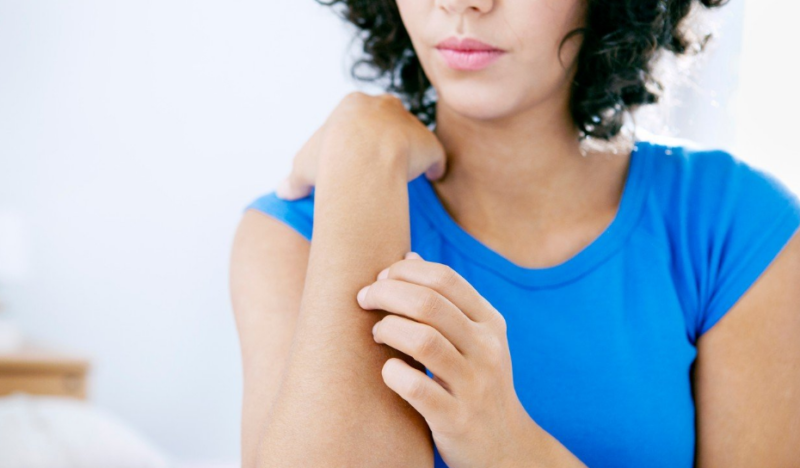Urticaria (urticaria) is a common manifestation of an allergic reaction of the body to medications, chemicals or products. As a rule, it passes quickly, but some people have chronic urticaria. From our article you will learn why such a phenomenon occurs, and how to treat it.
Material Content:
Description of chronic urticaria
The first manifestations of urticaria are characteristic skin rashes that resemble a burn with nettle leaves. The resulting light red blisters provoke severe itching.
About 90 percent of the world's population at least once encountered this phenomenon. Pathology is acute (OK) and chronic (HC).
- OK is often observed no more than 48 hours. Only occasionally can its manifestations be disturbing for several weeks in a row.
- If the patient persists for more than a month and a half, he is diagnosed with HC. This kind of disease can occur for a long time, even several years, periodically disappearing and activating again.
By the nature of the provoking factor, urticaria happens:
- infectious;
- autoimmune;
- allergic
- idiopathic.
Under the influence of certain diseases in the skin, histamine production is activated and vascular permeability increases. Accumulations of histamine cause edema, which often leads to inflammation. As a result, blisters and pimples appear on the body.
Numerous studies have shown that histamine synthesis is activated due to two elements - IgE and IgG.In large quantities, they are produced by those who are prone to allergies. Under their influence, urticaria occurs when in contact with an allergen.
In autoimmune disease, thyroid autoantibodies also appear that can cause hives.
If there is no obvious provocateur, the patient is diagnosed with idiopathic HC. This type of pathology is not yet fully understood.
Chronic idiopathic urticaria sometimes completely disappears, and the patient thinks that he was cured of it. But after a while her symptoms reappear. In this situation, the patient is diagnosed with recurrent HC.
Most often, relapse occurs due to:
- new contact of the body with the allergen;
- weakening of the immune system by the disease;
- helminth infections.
Causes in children and adults
The reasons that provoke HC are divided into groups:
- Infectious. Chronic infection and bacteria contribute to the development of HC. It is believed that the disease can cause: Helicobacter pylori, dental abscess, cholecystitis, infection of the bladder, prostatitis. But not always because of these diseases, the patient develops an allergic rash.
- Autoimmune. Such HC will be difficult and long to proceed, the use of antihistamine pharmaceuticals will not give positive results.
- Intolerance. Problem assimilation of food or drugs can provoke HC.
- Physical. This category includes: contact with allergens, poor tolerance of the sun, water, cold, vibration and pressure.
- Other. The group is represented by hormonal disruptions during puberty, the menstrual cycle and bearing a child. Cancer patients also develop symptoms of HC.
Scientists have not yet been able to establish the causes of idiopathic HC.
Symptoms and manifestations
This skin disease manifests itself:
- Red or pale pink blisters appearing throughout the body.
- Scars of various sizes and shapes. They can independently arise and disappear.
- Papules and plaques with a white dot in the middle.
- Itching, worse at night, makes the patient suffer from insomnia and neurotic disorders.
- Puffiness. Often the patient suffers from angioedema or Quincke's edema. At the place of their formation, skin tension, traces of peeling and cracks are observed.
Common manifestations of HC include:
- general malaise and weakness;
- bouts of nausea;
- joint pain
- loose stools;
- rise in temperature.
Diagnostic and treatment methods
Diagnosis of the disease is performed using:
- general blood test;
- fecal analysis;
- ESR;
- studies of antinuclear factor;
- blood tests for specific markers;
- electrophoretic analysis of proteins.
Treatment of chronic urticaria involves the appointment of a patient:
- antihistamines: Zirtek, Vistaril, Tavegil, Allergy;
- antagonists of leukotriene receptors: "Singular";
- antimicrobial and analgesic drugs: "Dapson" and "Colchicine";
- systemic corticosteroids: “Prednidozole”;
- "Cyclosoprine" and "Methotrexate";
- Levothyroxine.
Locally calm the manifestations of recurrent HC can be special gels and ointments:
- "Fenistil-gel";
- Advantan
- "Prednisolone ointment";
- Sinaflan.
Therapy of urticaria should be developed only by a qualified specialist.
Dietary Tips
In order for the chronic urticaria to quickly enter the stage of remission, the patient needs to follow certain recommendations for adjusting eating behavior.
In the diet should not be:
- spicy, fried, salty, spicy;
- chocolate, lollipops, cookies;
- citrus fruits;
- coffee and alcohol;
- seafood;
- nuts
- hard cheeses;
- honey.
The diet is recommended to be based on:
- poultry;
- cereals;
- fresh vegetables and fruits typical of our climate;
- herbal infusions and decoctions;
- olive and coconut oil.
Forecast and Prevention
In general, the prognosis regarding the further development of HC is positive, but on the condition that the patient will comply with all medical recommendations not only during treatment, but also after.
Prevention of pathology involves:
- compliance with the correct diet;
- minimal contact with various allergens (food, household);
- avoidance of stressful situations;
- maintaining a healthy lifestyle.
It is strictly forbidden to use any methods of therapy as self-medication. If the condition worsens, urgently need to seek qualified medical help.














